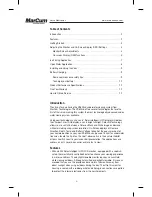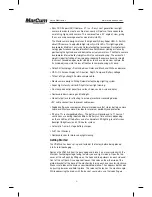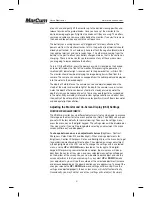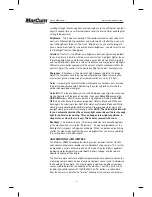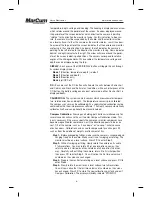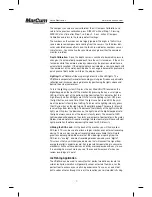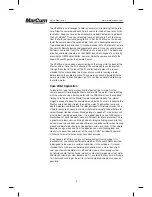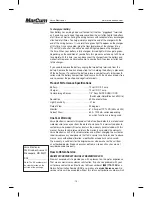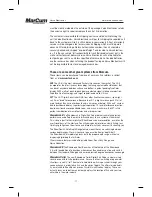
Versa Electronics
www.marcumtech.com
- 8 -
The VS625sd is small enough to hold in your arms while walking from hole to
hole. Drop the camera down each hole in search for the best spot or until you
locate fish. Keep your eye on the directional and depth indicators to pinpoint
the fish’s hideout. Once you’ve located the spot, drill a hole 3 or 4 feet away
from the hole you’re actually going to fish in. Set the VS625sd on the ice and
lower the camera down the second hole. To assist in keeping the camera at
the desired depth and direction, it is recommended that an Automatic Camera
Panner with Remote (purchased separately) be used. Once you send a lure or
bait down and locate it with the VS625sd, you’re ready to fish. The depth and
direction and temp indicators on the VS625sd can be changed at any time by
pressing the OSD/Display button. Lower or Raise the camera and rotate the
head with your fingers or the Camera Panner.
The VS625sd also includes a down viewing fin that snaps into the back of the
Manta camera. Once the fin is attached, the camera cable can be inserted
through the cutout at the rear of the fin and locked into place. It is recom-
mended that you leave about six inches of excess cable, forming a loop,
before locking the cable into place. The camera can now be lowered into the
hole to view what is directly below you. This can be very helpful while fishing
in shallow water.
Open Water Application
To locate fish, look for treasure or find that perfect spot, simply turn the
camera power ON and drop the Manta camera into the water. If you’re drifting
with the wind or using a trolling motor with the VS625sd, attach the supplied
trolling fin to the rear of the Manta Camera for added stability. The internal
weight is enough to keep the camera down while the fin assists in keeping the
Manta camera tracking straight through the water. The direction, temp and
depth indicators combined with the solar intelligent H2D display makes this is
ultimate search tool. Learn in minutes what would normally take a lifetime to
reveal through traditional sonar. Moving along at speeds of 1 mph or less will
give the best viewing opportunities. It is a good idea to have a GPS and/or a
marker buoy at hand to quickly mark any hotspots for future reference. This is
a great way to learn new ice fishing hotspots. Imagine finding a rock pile that
no one else on your lake knows about! Always use extra caution when viewing
around underwater obstructions, like boulders, cribs, or wrecks. If the camera
becomes hung up, back up from the direction you were traveling from and
slowly try to back the camera out of the snag. DO NOT pull directly upward
with force unless all other avenues have been pursued.
If you spend a lot of time using your Viewing System from your boat, it is
inevitable that you will encounter some weather. While your VS625sd system
is designed to be used in a variety of conditions in the outdoors, it is recom-
mended that anytime you experience precipitation that is more than a light
rain, you should immediately turn off and stow your entire viewing system.
At no time should the monitor be in direct contact with large amounts of water.
Should your viewing system become wet, it is unlikely that any harm will come
to it, but make sure to get the entire system completely dried out as soon as
possible.


